Letters from Lodi
An insightful and objective look at viticulture and winemaking from the Lodi
Appellation and the growers and vintners behind these crafts. Told from the
perspective of multi-award winning wine journalist, Randy Caparoso.
Factors explaining Zinfandel's spectacular food-versatility
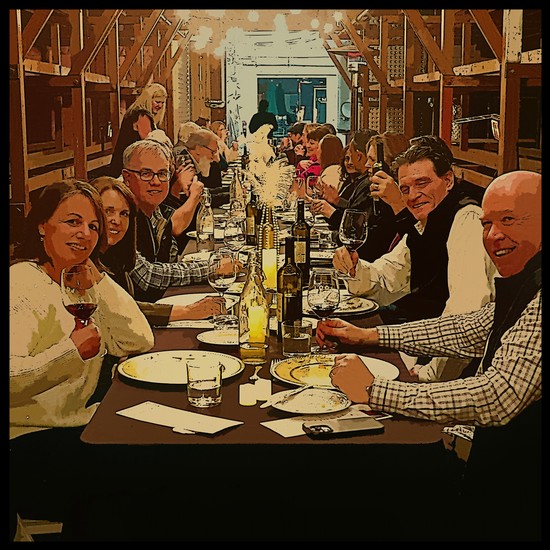
Cellar dinner at St. Amant Winery, a Lodi Zinfandel specialist.
The environmental factor
It's time to talk about Zinfandel. Oh, I admit, for me, it's always time to talk about Zinfandel. That is because I am what people often used to call a "foodie." Better than "wine geek," I guess.
Be as it may, Zinfandel is a far, far more food-versatile wine than many wine lovers (especially the geeks) may think. I came to that conclusion after over 30 years of observation and logical conclusions working in or with restaurants, my former career. Even today, when reaching for a bottle for dinner, I am more likely to pop open a Zinfandel than any other varietal wine of any color.
As a restaurateur, my job always involved wine training, which was often done with dishes to get staff familiar with how wines end up tasting with dishes. A common practice was to present multiple wines⏤typically a mix of dry sparkling wine, a Chardonnay, a Sauvignon Blanc, a Pinot Noir, a Cabernet Sauvignon and/or a Zinfandel⏤with three or four different dishes, and having the staff taste all the wines with each dish. In almost every case, the wine that seemed to compliment the most dishes would be a Zinfandel. Seafood, meat, pasta, salad, pizza, appetizers of all sorts⏤it usually didn't matter, my staff usually found that Zinfandel, compared to all other wines, had the highest percentage chance of tasting great with a dish.

Tasting Zinfandel in the ancient vine (over 100 years old) Lodi vineyard from where the wine is sourced.
And it never really mattered what kind of Zinfandel. It could be a light and lean style of Zinfandel, an oversized and ultra-fruity Zinfandel, a richly oaked or spicy Zinfandel, or a subtle, floral style of Zinfandel⏤it just didn't matter, Zinfandel invariably made the better match.
As a grape or cultivar planted in the ground, Zinfandel is amazing. Wine connoisseurs know that in European countries, the birthplace of wines, Zinfandel is an extremely minor variety on the scale of importance. It originated in Croatia and was transplanted to Southern Italy sometime during the early 1800s, where it remained so obscure that it wasn't until the 1960s that a grapevine scientist suddenly "discovered" that the plant, cultivated as Primitivo in Italy, was exactly the same variety called Zinfandel in California.
Yet think of how the wine industry first evolved in California: Following statehood (in 1850) when people poured in from all around the world, grapevine entrepreneurs began planting every grape of European origin they could get their hands on, up and down the state, from Los Angeles to Mendocino, the Channel Islands off the coast of Southern California to the foothills of the Sierra Nevada. First-time grape pioneers would typically plant at least half a dozen or as many as two or three dozen different grapes to see what grows, or sells, the best.

Cut-out from a panoramic 1921 photo of Henry George Mettler in his family's Lodi Zinfandel block.
By the 1880s one grape emerged as the easiest to plant and easiest to make a respectable wine from: Zinfandel, of course. It didn't matter that no one really knew where the grape originated⏤information that had somehow been lost by the nineteenth-century East Coast nurseries that originally supplied the plant material shipped into California⏤because, by the turn of the last century, Zinfandel had become The Golden State's most widely planted wine grape.
And because Zinfandel was the most widely planted, it was also called "California's Grape," as if it was native to the state.
Therein lies the reason why Zinfandel is so food-versatile: It easily proved itself, through consistent trial-and-error, to be the one European cultivar that was most easily adaptable to almost all of California's wine regions⏤dominated by variations of what is classified as Mediterranean climate⏤and, as a direct result, produces the most consistently well balanced and flavorful red wines. It is that balance of sensory qualities that allows Zinfandels to taste great with a wide range of foods.
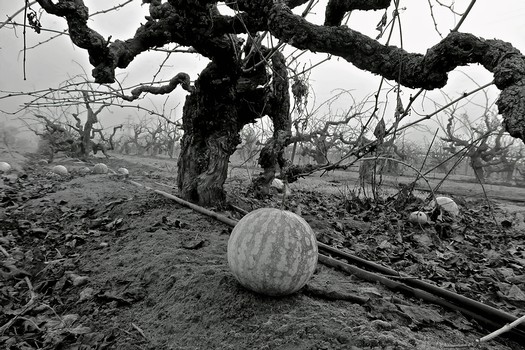
Wild watermelons—vestiges of a time (during the 1880s) when Lodi was known as the "Watermelon Capital of the Country"—popping up spontaneously in an ancient vine Zinfandel block originally planted in 1889.
The Köppen classification defines Mediterranean climates as having "hot, dry summers and cool, wet winters." In terms of growing season patterns, Mediterranean climates are also marked by diurnal swings⏤anywhere from 30° to 45° F. swings between day and night-time temperatures wherever grapes are grown in California. Zinfandel, more than any other European wine grape (i.e., Vitis vinifera), absolutely thrives in these conditions because it loves the heat of the hottest summer days, while cool nights allow the grape to retain a fresh fruit profile with ample acidity.
This, in fact, is the reason why there is, easily, far more Zinfandel grown in Lodi than in any other region in California, plus far more "old vine" plantings (over 50 to 100 years old). It is in Lodi, among the warmest of California's Mediterranean climate zones, that the cultivar has found an ideal environment. It is the variety's grapevine health and propensity to produce high-quality wine, plain and simple, that explains the grape's century-and-a-half-long history of economic success in the Lodi appellation.
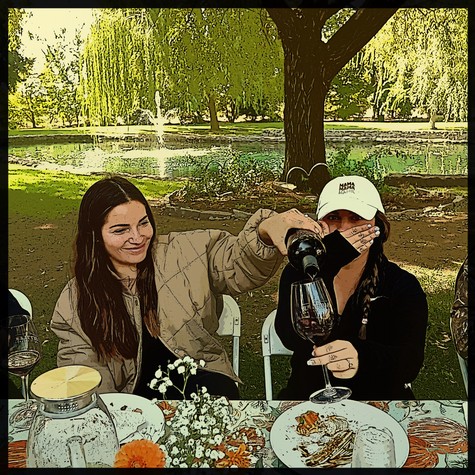
Lodi Zinfandel lunch at Mettler Family Vineyards.
The factor of acidity
One of the long-accepted principles of wine appreciation is that both the quality and longevity of a given wine are due primarily to its acid balance. In a conversation a few years ago, Turley/Sandlands winemaker Tegan Passalacqua pointed out that in courses taught by Master Sommeliers, one of the sensory markers students are told to look for when trying to delineate a Zinfandel from a Pinot Noir in blind tastings is acid level⏤Zinfandels usually have a zestier acid edge than Pinot Noirs.
Zinfandel as a varietal is known to retain acidity in both cooler climates, such as in Sonoma County's Russian River Valley or atop Mendocino Ridge, and in warmer climates such as Paso Robles, Amador County, or Lodi. There are, in fact, vineyards in Lodi where picking decisions are based as much or more upon acid levels than on sugar ripeness: Vintners typically wait for acidity in grapes to drop when deciding when to pick.
On a sensory level, it is acidity that makes a red wine such as Zinfandel vibrant in its fruit expression, in the nose as well as on the palate, and more likely to match a wider range of dishes.
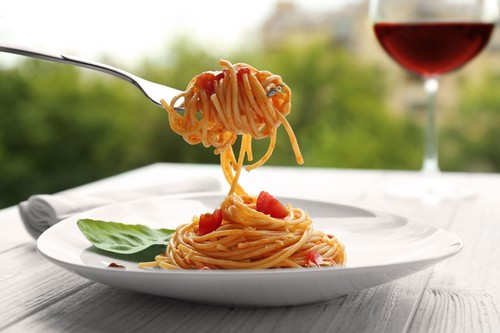
It is precisely because Zinfandel is all about acidity that it goes easily with pasta in zesty tomato sauce; or in a dish like this one laced with peperoncino, which rings a bell with Zinfandel's peppery spice qualities.
It is the intrinsic acidity in the Zinfandel grape, in fact, which made it such an ideal wine for the production of the medium-sweet, fruity pink wines⏤the once ubiquitous “White Zinfandel" category⏤so popular between the mid-1980s and early 2000s. Especially if you love sweet wines, you need a wine to have ample enough acidity to keep it from being cloying, allowing you to drink lots and lots of it.
Old-time growers and vintners all talk about the way red Zinfandels were produced before the 1980s when Zinfandel grapes were typically picked at about 22° Brix (i.e., sugar reading), which would convert to no more than 12% or 12.5% alcohol in wines. Anything bigger than that used to be considered overripe, alcoholic, or just plain weird. The popular California brands of the 1960s⏤such as Sebastiani, Parducci, and Louis Martini⏤produced Zinfandel in exactly this way, fairly simple, soft in tannin, and restrained yet zesty in fruit qualities. Wines practically beg for Italian-style dishes, such as spaghetti or lasagne in tomato sauce.

The yearly gigantic Zinfandel celebrations in San Francisco started by ZAP (Zinfandel Advocates & Producers) in 1991 helped fuel the consumer mania for big, ultra-ripe style Zinfandels in the 1990s.
During the 1980s and start of the '90s, Zinfandels started to get fuller bodied, sometimes huge; picked at a minimum of 25° Brix to produce red wines with alcoholic strengths of 14% (at the least), 15%, and even 16% or more. More than anything, this became a trend because consumers just getting into California wine really, really loved the characteristics of the grape when picked at higher sugars: Especially the "jammy" aromas suggesting black cherry, raspberry, blackberry, or even blueberry, often mixed with exhilarating whiffs of freshly ground pepper, cinnamon or clove, enriched by Petite Sirah (a grape contributing additional color, tannin and spice) as well as oak qualities piling on notes of toasted wood, like burning leaves of autumn.
Over the past ten or so years, tastes have begun to swing back, although not quite as far as the '60s and early '70s. Today, the norm for commercial Zinfandel practically everywhere in the state is now closer to 14% or 14.5% ABV.
If anything, the level of alcohol in top-quality Zinfandel is overrated as a quality factor. Sure, 15.5% ABV Zinfandels tend to come across as bigger and more intense than 13.5% or 14% Zinfandels, yet at the same time they are no less fragrant or vibrantly fruited.
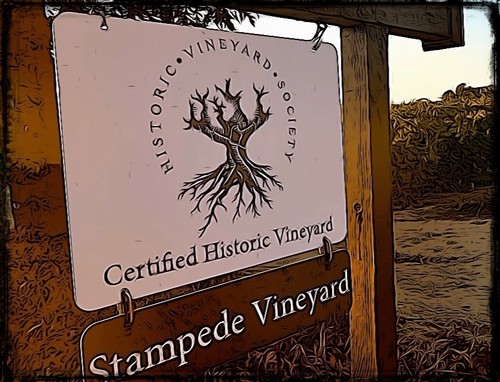
Lodi's Stampede Vineyard, certified by the Historic Vineyard Society, is well known for its high-acid style old vine Zinfandel.
What is amazing, after all these years, is how even the 15% or 16% Zinfandels of the 1990s and early 2000s, when opened today, are still coming across as well-balanced, and just as food-versatile (see our recent post, Winemakers and journalists taste and talk about aged Lodi wines, up to 27 years old). The primary reason is that the varietal typically retains ample acidity whether made in a light and zesty fashion or in a big, bruising style, and it is also acidity that drives longevity.
A lot of this, again, goes back to the environment; that is, the circumstances allowing grapevines to thrive in specific sites over 50, 75, or even 100 years. The advantage of Zinfandels made from older vines is that they retain not just a great depth and intensity of balanced qualities, but also a stronger sense of place (or what the French call terroir). Ultimately, older vines just make for better wine to sip and savor, better wine to enjoy with food, and better wines for long-term aging.
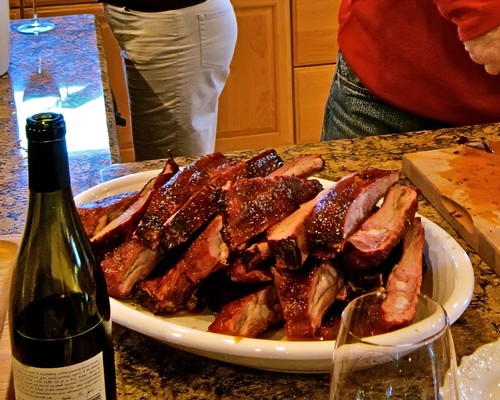
Sweet/zesty/spicy marinated and wood smoked baby back ribs, which have all the components to match the spiced fruit scented and smoky oak enriched qualities of typical California Zinfandel.
Food factors
Just how good are contemporary-style Zinfandels with food? I wouldn’t argue if you say that beef is always best with Cabernet Sauvignon, but I’ve been amazed by how well a sturdy, sweetly berryish Zinfandel goes with roasted prime rib bathed in horseradish-tinged natural jus, or a simple charred sirloin doused in Tabasco bringing out the intrinsic rotundone (peppery components) of the grape. Heck, grilled hamburger doused with ketchup is a no-brainer with Zinfandel.
The intensely fruited and spiced qualities of Zinfandel are also the reason why it makes such an easy cross-cultural match when it comes to beef. Think of thin slices of beef steeped in soy, palm sugar, sesame, garlic, and ginger in the fashion of Japanese, Mongolian, and Korean marinades, charcoal grilled or seared on a smoking hot iron, and plopped on steamy white rice.
Asian food contexts, in fact, are a culinary ground Cabernet Sauvignon and even Merlot usually have a hard time covering, whereas the sweet berry concentration of typical Zinfandels of today seem to have no problem. When it comes to fusion or Asian-style treatments of any meat—in sauces based upon the salty/umami sensations of soy sauce, or even sweet, bitter, or spicy ingredients such as ketchup, hot mustards, or sriracha—Zinfandel goes where few other wines can.
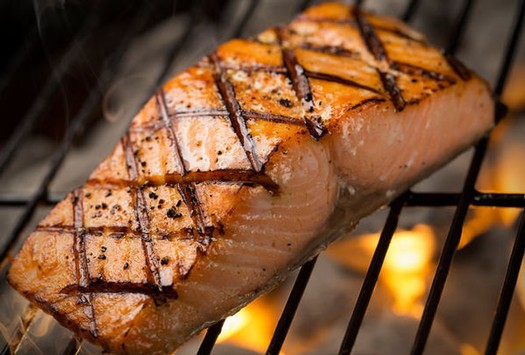
A meaty, fatty fish such as salmon is a natural partner with restrained styles of Zinfandel; especially when grilled and marinated in an Asian-influenced style, with soy sauce, red peppers, and balsamic vinegar. dining.nd.edu
It is also said that lamb calls for Cabernet Sauvignon or else classic red Bordeaux. Early on during the 1970s and '80s, when Zinfandels started to become bigger, jammier, and oakier, we discovered that these styles of the varietal tasted just as great with legs of lamb caked with sweet or hot mustard, lamb chops grilled with chunks of eggplant, bell peppers or portobellos, and entire racks coming out of the roaster dripping with buttery bread crumbs, slathered in sweet mint jelly or drizzled with sweet balsamic—fatty, sweet, charred, caramelized, earthy, bitter, spicy, or even vinegary sensations. There didn’t seem to be much that the more intensely fruited styles of Zinfandel couldn’t handle, with aplomb.
Then there is the “other” white meat: Almost any variation of pork; from Italian sausages to chorizo, or from chops pan-fried with pungent herbs (rosemary, thyme, herbes de Provence, etc.) to roasts smothered in wine, herbs, or zesty barbecue sauces. Zinfandel and pork are such natural partners, that you’d have to be either blissfully ignorant or a hopelessly effete snob to say that Zinfandels, big or moderately weighted, don’t make good “food” wines.
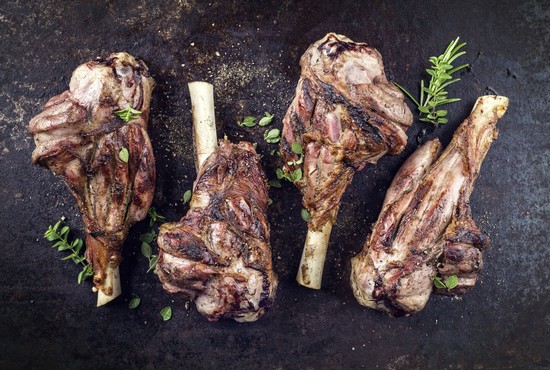
Lamb shanks braised in wine and Mediterranean herbs such as rosemary and thyme make an easy match with Zinfandel. californialamb.com.
While Zinfandel is an acid-driven wine, it goes without saying that tannin—the phenolic compounds derived from grape skins and seeds that give red wines their hard or bitter taste, especially when young—also plays a part in Zinfandel and food matching, just as it does in all the world’s finer styles of red wine. But the funny thing about Zinfandel is that, in terms of phenolic content, the varietal is more like wines made from Pinot noir or Grenache than varieties such as Cabernet Sauvignon, Syrah, Nebbiolo or Tempranillo. Pure Zinfandels do not have a large amount of tannin. Yet we know that, like a good Pinot noir or Grenache coming off of favorable sites, a finely crafted, well-balanced Zinfandel can age just as gracefully as the darkest, highest tannin reds, making them, if anything, even more food-versatile.
IDEAL ZINFANDEL FOOD MATCHES
A few remarks on the myriad food possibilities of Zinfandel:
• For bigger-sized Zinfandels (generously oaked, blended with Petite Sirah and closer to 15% or 16% alcohol), bring on the fattiest or wildest, full-flavored meats—venison, boar, buffalo, elk, and maybe even squab or goose—and slather them with the seasonings and spices (including hot chilies, if balanced with ingredients that are mildly sweet, salty, sour, etc.) you like, because Zinfandel’s combination of tannin, acidic zip, and sweetly fruit-forward flavors go where few other reds can.
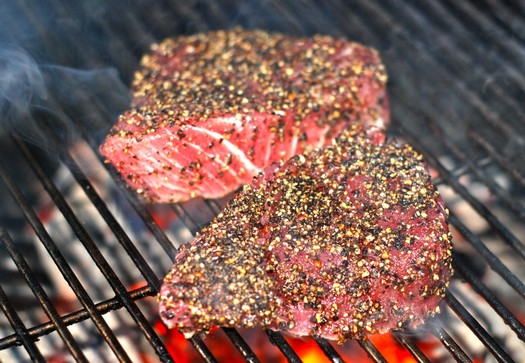
Tuna is a red-fleshed fish that almost always goes best with red wines; and when grilled, marinated with sesame oil, and crusted with peppercorns, it connects easily with Zinfandel's intense fruit and peppery spice. grillgirl.com.jpeg
• The zesty fruit quality of moderately scaled Zinfandels (more acid-driven styles purer in varietal content, with softer tannins, less oak influence, and less than 14% alcohol) actually makes it a good candidate for red-wine-with-fish combinations (providing you grill, sauce, or season the fish with zin-friendly methodology). Fattier fish such as salmon or tuna are particularly good in this context.
• Variations of earthy tastes such as mustards and mustard greens (as underlying components that help reduce bitter tannins), bell peppers and chile peppers (can heighten grape’s peppery spice), peppercorns and corning (the grape’s “jammy” sensations can handle some salting), garlic and onions (accents the grape’s sweetness), caramelized beets (sweet root vegetables embellish Zinfandel fruitiness), as well as mushrooms and goat cheeses (Zinfandel has just enough zest to balance acidity in chèvre) all get along famously with Zinfandel’s unique multifaceted profile.

Another easy match for zesty Zinfandels is the many variations of wood oven pizza, such as Wolfgang Puck's classic smoked salmon pie lavished with sour cream, caviar, and umami-rich scallions. mashed.com.
• Marinades in combination with wood or charcoal grilling, smoking, and roasting to create caramelized flavors can “sweeten” the briary, berry taste of Zinfandel, and round out its rougher edges.
• Use of sweet/acidic fruits like tomatoes, berries, and cherries can also match the varietal profile and reduce the effect of tannins in young, unruly Zinfandels.
• The aromatic Mediterranean herbs such as rosemary, bay leaf, oregano, thyme, sweet basil, marjoram and savory add contrasting notes to Zinfandel fruitiness (but not so much fragrant herbs like mint, cilantro, dill, and tarragon); arugula, cress, dandelion, and other peppery/nutty greens play to the grape’s peppery spice; and spare, thoughtful use of star anise, juniper, mace, ginger, caraway, clove, sumac, and seeds of anise, poppy, and sesame can all work with peppercorns to embellish the sweetly spiced varietal character.
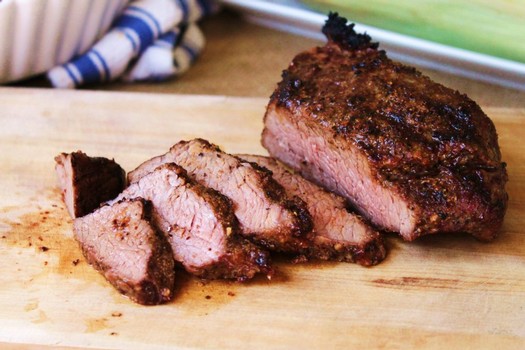
Mesquite smoked beef tri-tips are a no-brainer for any sturdy red wine, but can be made even more zin-friendly by marinating in Zinfandel with cracked black peppercorn. kamprite.com
• Plump, fatty sausage meats, with black or red peppers and seed spices; especially when used as meat stuffings (or plopped between buns, for that matter).
• Finally, while like most deep-flavored red wines Zinfandel is easily complimented by deep-flavored, firm, umami intensified aged cheeses such as Parmigiano, pecorino, manchego, cheddars, and goudas, the varietal can also cross lines to softer cheeses given specific zin-friendly components. For instance, Italian herb-crusted chèvres and white truffle-specked bruschetta al Tartufo merge effortlessly with the sweet berry jam qualities of even the biggest zins. By the same token, a chili pepper pecorino’s subtle spice and grassy edge bring out the peppery spice in the varietal, while the deep, crystal-caramelized taste of "super-aged" goudas (such as Beemster 18-year-old or XO) underscore the richest Zinfandel’s generous fruitiness.
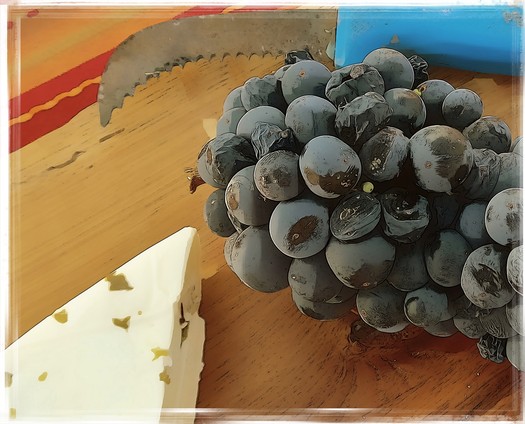
While deeper-colored, well-aged cheeses are the natural match for red wines such as Zinfandel, the varietal has enough acid balance to taste great even with zesty soft cheeses such as chèvre, especially when infused with pungent herbs.